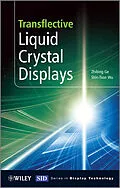Sunlight readable transflective liquid crystal displays, used on devices from cell phones and portable media players, to GPS and even some desktop monitors, have become indispensable in our day-to-day lives.
Transflective Liquid Crystal Displays is a methodical examination of this display technology, providing a useful reference to the fundamentals of the topic. Including thorough descriptions of the essential physics of transflective LCD technologies, the book also compares transflective LCD technology with alternatives, such as OLED displays, to enable display engineers to appropriately select the correct device for their particular application.
- Includes detailed descriptions of both pure transmissive and reflective LCDs, and the design considerations and performance of combining these into small mobile displays.
- Focuses on fundamental elements, such as double cell gap transflective LCDs, wide-viewing angle technology, light polarization and wide-view linear and circular polarizers, video rate display by colour sequential technologies, colour sciences and engineering, and backlights.
- Describes the latest LCD technologies, such as polymer-sustained surface alignment technology, and the possible trends which could be applied to transflective LCDs in the future.
Its focus on the fundamentals of transflective liquid crystal displays makes this an ideal graduate text, while display engineers, scientists, developers and technicians working with this technology will also welcome this resource.
The Society for Information Display (SID) is an international society, which has the aim of encouraging the development of all aspects of the field of information display. Complementary to the aims of the society, the Wiley-SID series is intended to explain the latest developments in information display technology at a professional level. The broad scope of the series addresses all facets of information displays from technical aspects through systems and prototypes to standards and ergonomics
Autorentext
Zhibing Ge, College of Optics and Photonics, University of Central Florida, USA
Dr Ge joined the College of Optics and Photonics at the University of Central Florida in 2008 as a research scientist. His research interests include liquid crystal displays and laser beam steering technologies. Dr. Ge is a member of the IEEE and SID. He is a recipient of the 2006 IEEE LEOS Graduate Student Fellowship Award, 2007 Otto Lehmann Award and 2007 UCF Outstanding Dissertation Award. Dr Ge serves as an associate editor for Journal of Society for Information Display (JSID) on the LCD division. He has published 1 book chapter, over 20 journal papers and has 12 issued or pending patents.
Shin-Tson Wu, College of Optics and Photonics, University of Central Florida, USA
Currently PREP Professor of Optics at the University of Central Florida. Professor Wu is a Fellow of the IEEE, OSA, SID and SPIE. He is a recipient of the SPIE G. G. Stokes Award, SID Jan Rajchman Prize, UCF Distinguished Researcher Award, IEEE Outstanding Engineer Award, SID Special Recognition Award, ERSO (Taiwan) Special Achievement Award and Hughes team achievement award. From 2004-2008, Professor Wu served as the founding Editor-In-Chief of the IEEE/OSA Journal of Display Technology. He has co-authored 5 books (4 with Wiley, 1 with world scientific press), 6 book chapters, over 300 journal papers and has more than 75 issued and pending patents. Several of his patents have been implemented in display and photonic devices.
Inhalt
Series Editor's Foreword ix
About the Authors xi
Preface xiii
1 Device Concept of Transflective Liquid Crystal Displays 1
1.1 Overview 1
1.2 Polarizers 6
1.2.1 Linear Polarizers 6
1.2.2 Circular Polarizers 8
1.3 LC Alignment 13
1.3.1 Twisted Nematic (TN) Mode 13
1.3.2 Homogeneous Alignment Mode 19
1.3.3 In-plane Switching (IPS) Mode 20
1.3.4 Vertical Alignment (VA) Mode 26
1.3.5 Hybrid Aligned Nematic (HAN) Mode 28
1.3.6 Pi-cell or Optically Compensated Bend (OCB) Alignment Mode 29
1.4 Compensation Films 31
1.4.1 Deviation of Effective Polarizer Angle 31
1.4.2 Phase Retardation from Uniaxial Medium 33
1.4.3 Uniaxial and Biaxial Films 35
1.5 Reflectors 37
1.5.1 Parallax and Ambient Contrast Ratio 37
1.5.2 Reflector Designs 40
1.6 Backlight 43
1.6.1 Backlight Configuration 43
1.6.2 CCFL and LED Light Sources 44
1.6.3 Other Backlight Elements and Films 48
1.7 Summary 54
References 54
2 Device Physics and Modeling 59
2.1 Overview 59
2.2 Modeling of LC Directors 60
2.2.1 Free Energy of Liquid Crystal Devices 60
2.2.2 LC Simulation Flow Chart 64
2.3 Modeling of LC Optics 69
2.3.1 4 4 Matrix Method 69
2.3.2 2 2 Extended Jones Matrix Method 75
2.3.3 Numerical Examples 77
2.4 Device Physics of Transflective LCDs 82
2.4.1 Transflective LCDs Using Dual Cell Gaps 82
2.4.2 Transflective LCDs Using Dual Gamma Curves 87
2.4.3 Transflective LCDs Using Dual Electric Fields 89
2.4.4 Transflective LCDs Using Dual Alignment 96
2.5 Summary 100
Appendix 2.a 101
References 104
3 Light Polarization and Wide Viewing Angle 109
3.1 Poincaré Sphere for Light Polarization in LCDs 109
3.2 Compensation of Linear Polarizers 112
3.2.1 Deviation of the Effective Angle of Crossed Linear Polarizers 112
3.2.2 Compensation of Linear Polarizers using Uniaxial Films 113
3.2.3 Compensation of Linear Polarizers using Biaxial Films 117
3.3 Compensation of Circular Polarizers 122
3.3.1 Broadband and Wide-view Circular Polarizers 122
3.3.2 Narrow-band and Wide-view Circular Polarizers 132
3.4 Summary 143
References 144
4 Wide-view Transflective LCDs 147
4.1 Overview 147
4.2 Transflective LCD Using MVA Mode 148
4.2.1 MVA Technology Overview 148
4.2.2 Mobile MVA Technology 155
4.3 Transflective LCD Using IPS Mode 157
4.3.1 IPS and FFS Technology Overview 157
4.3.2 Transflective IPS and FFS Technology 166
4.4 Summary 181
References 182
5 Color Sequential Mobile LCDs 189
5.1 Overview 189
5.2 Color Sequential Driving Schemes 190
5.3 Fast-response LC Modes 193
5.3.1 Thin Cells with High Birefringence LC Material 193
5.3.2 Bend Cells 194
5.4 Fast-response Transflective LCDs 199
5.4.1 Conventional Transflective LCDs Using OCB Modes 199
5.4.2 Color Sequential Transflective LCDs 203
5.5 Summary 208
References 209
6 Technological Perspective 213
6.1 Unique Role of Transflective LCDs 213
6.2 Emerging Touch Panel Technology 218
6.3 Summary 224
References 225
Index 227
